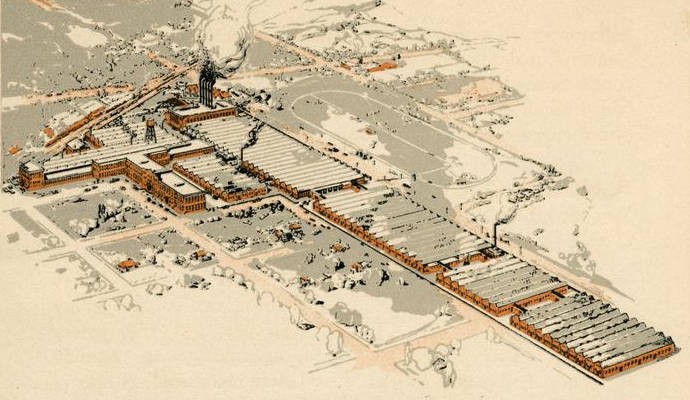|
Carrozzeria Varesina
Carrozzeria Varesina (established 1845 in Varese) was an Italian coachbuilder, known for their work on industrial vehicles such as double-decker buses for both touring and urban transport. Among their models was ten units of the "Filobus" Alfa Romeo 110AF (1939). They also made bodies for prototypes of cars for companies such as Lancia and Zagato Zagato is a Coachbuilder, coachbuilding company founded by Ugo Zagato in 1919. The design center of the company is located in Terrazzano, a village near Rho, Lombardy, Italy. History The 1910s: Aeronautics Ugo Zagato was an Italians, Italian .... A current company with the same name and area of expertise (established 1975) resides in Ospiate di Bollate. References [...More Info...] [...Related Items...] OR: [Wikipedia] [Google] [Baidu] [Amazon] |
Automotive Industry
The automotive industry comprises a wide range of company, companies and organizations involved in the design, Business development, development, manufacturing, marketing, selling, Maintenance, repairing, and Custom car, modification of motor vehicles. It is one of the world's largest industry (economics), industries by revenue (from 16% such as in France up to 40% in countries such as Slovakia). The word ''automotive'' comes from the Greek language, Greek ''autos'' (self), and Latin ''motivus'' (of motion), referring to any form of self-powered vehicle. This term, as proposed by Elmer Ambrose Sperry, Elmer Sperry (1860–1930), first came into use to describe automobiles in 1898. History The automotive industry began in the 1860s with hundreds of manufacturers pioneering the Brass Era car, horseless carriage. Early car manufacturing involved manual assembly by a human worker. The process evolved from engineers working on a stationary car to a conveyor belt system where the ... [...More Info...] [...Related Items...] OR: [Wikipedia] [Google] [Baidu] [Amazon] |
Varese
Varese ( , ; or ; ; ; archaic ) is a city and ''comune'' in north-western Lombardy, northern Italy, north-west of Milan. The population of Varese in 2018 was 80,559. It is the capital of the Province of Varese. The hinterland or exurban part of the city is called ''Varesotto''. Geography The city of Varese lies at the foot of Sacro Monte di Varese, part of the Campo dei Fiori di Varese, Campo dei Fiori mountain range, that hosts an astronomical observatory, as well as the Prealpino Geophysical Centre. The village which is in the middle of the mountain is called Santa Maria del Monte because of the medieval sanctuary, which is reached through the avenue of the chapels of the Sacred Mountain. Varese is situated on seven hills: the San Pedrino Hill, the Giubiano Hill, the Campigli Hill, the Sant'Albino Hill, the Biumo Superiore Hill, Colle di Montalbano (Villa Mirabello) and the Hill of Miogni. The city also looks over Lake Varese. Climate Varese's winters are not signific ... [...More Info...] [...Related Items...] OR: [Wikipedia] [Google] [Baidu] [Amazon] |
Lombardy
The Lombardy Region (; ) is an administrative regions of Italy, region of Italy that covers ; it is located in northern Italy and has a population of about 10 million people, constituting more than one-sixth of Italy's population. Lombardy is located between the Alps mountain range and tributaries of the river Po (river), Po, and includes Milan, its capital, the largest metropolitan area in the country, and among the largest in the EU. Its territory is divided into 1,502 ''comuni'' (the region with the largest number of ''comuni'' in the entire national territory), distributed among twelve administrative subdivisions (eleven Provinces of Italy, provinces plus the Metropolitan City of Milan). The region ranks first in Italy in terms of population, population density, and number of local authorities, while it is fourth in terms of surface area, after Sicily, Piedmont, and Sardinia. It is the second-most populous Region (Europe), region of the European Union (EU), and the List of ... [...More Info...] [...Related Items...] OR: [Wikipedia] [Google] [Baidu] [Amazon] |
Bollate
Bollate (Milanese: ) is a ''comune'' (municipality) in the Metropolitan City of Milan in the Italy, Italian region Lombardy, located about northwest of Milan. As of 30 November 2017, it had a population of 36,488. Bollate borders the following municipalities: Paderno Dugnano, Senago, Garbagnate Milanese, Arese, Cormano, Novate Milanese, Baranzate, Milan. Bollate received the honorary title of city, with a presidential decree on 11 October 1984. It is served by Bollate Centro railway station and Bollate Nord railway station. Sights include the historical Villa Arconati, Bollate, Villa Arconati. References External links Official website * Bollate Prison Bollate, {{Milan-geo-stub ... [...More Info...] [...Related Items...] OR: [Wikipedia] [Google] [Baidu] [Amazon] |
Double-decker Bus
A double-decker bus is a bus that has two storeys or decks. Double-deckers are used primarily for commuter transport, but open-top models are used as sightseeing buses for tourists, and there are coaches too for long-distance travel. They appear in many places around the world but are presently most commonly used as mass transport in cities of Britain, and in Ireland, China, Hong Kong, Berlin and Singapore. The earliest double-decker horse-drawn omnibus appeared in Paris in 1853 and such vehicles were motorised in the 1900s. Double-decker buses were popularised in Great Britain at the start of the 20th century and today the best-known example is the red London bus, namely the AEC Routemaster. Double-deckers in urban transport were also in common use in other places, such as major cities of India, but were mostly diminished or phased out by the end of the 20th century. However they remain common in Britain as well as Ireland and Hong Kong, while in Singapore and Dhaka they ... [...More Info...] [...Related Items...] OR: [Wikipedia] [Google] [Baidu] [Amazon] |
Coachbuilder
A coachbuilder manufactures bodies for passenger-carrying vehicles. The trade of producing coachwork began with bodies for horse-drawn vehicles. Today it includes custom automobiles, buses, Coach (bus), motor coaches, and passenger car (rail), railway carriages. The word "coach" was derived from the Hungarian town of Kocs. A vehicle body constructed by a coachbuilder may be called a "coachbuilt body" (British English) or "custom body" (American English), and is not to be confused with a custom car. Prior to the popularization of unibody construction in the 1960s, many independent coachbuilders built bodies on rolling chassis provided by Luxury car, luxury or sports car manufacturers, both for individual customers and makers themselves. Marques such as Ferrari originally outsourced all bodywork to coachbuilders such as Pininfarina and Carrozzeria Scaglietti, Scaglietti. Today, the coach building trade has largely shifted to making bodies for short runs of specialized com ... [...More Info...] [...Related Items...] OR: [Wikipedia] [Google] [Baidu] [Amazon] |
Double-decker Buses
A double-decker bus is a bus that has two storeys or decks. Double-deckers are used primarily for commuter transport, but Open top bus, open-top models are used as sightseeing buses for tourists, and there are Coach (bus), coaches too for long-distance travel. They appear in many places around the world but are presently most commonly used as mass transport in cities of United Kingdom, Britain, and in Republic of Ireland, Ireland, China, Hong Kong, Berlin and Singapore. The earliest double-decker horse-drawn omnibus appeared in Paris in 1853 and such vehicles were Motor vehicle, motorised in the 1900s. Double-decker buses were popularised in Great Britain at the start of the 20th century and today the best-known example is the Buses in London, red London bus, namely the AEC Routemaster. Double-deckers in urban transport were also in common use in other places, such as major cities of India, but were mostly diminished or phased out by the end of the 20th century. However they rema ... [...More Info...] [...Related Items...] OR: [Wikipedia] [Google] [Baidu] [Amazon] |
Alfa Romeo 110AF
Alfa Romeo 110AF is an Italian trolleybus produced by Alfa Romeo from 1939 to 1944. History This model of trolleybus was in use in Rome, Milan, Naples, Genoa and Salerno until 1973 which is testimony of its long life. It use Breda MTR 290/230 motor. The short version was long and the other was and had three axles. With 45 seats, it had a capacity for 89 people. The trolleybus is notably featured in the 1953 Italian film '' La signora senza camelie''. Production * Model 110 AF/5 from Macchi – Breda (20 examples) * Model 110 AF/5 from Varesina – Breda (10 examples) * Model 110 AF/8 from Macchi – CGE (10 examples) See also * List of buses Year refers to the first year introduced. A range of years is the period the bus was manufactured. 0–9 A B C D E F G H I J K L M N O P Q R S ... References 110AF {{Bus-stub ... [...More Info...] [...Related Items...] OR: [Wikipedia] [Google] [Baidu] [Amazon] |
Lancia
Lancia Automobiles S.p.A. () is an Italian car manufacturer and a subsidiary of Stellantis Europe, which is the European subsidiary of Stellantis. The present legal entity of Lancia was formed in January 2007 when its corporate parent reorganised its businesses, but its history is traced back to ''Lancia & C.'', a manufacturing concern founded in 1906 in Turin, Torino by Vincenzo Lancia (1881–1937) and Claudio Fogolin. It became part of Fiat in 1969. The brand is known for its strong rallying heritage, and technical innovations such as the Vehicle frame#Unibody, unibody chassis of the 1922 Lancia Lambda, Lambda and the five-speed gearbox introduced in the 1948 Lancia Ardea, Ardea. Despite not competing in the World Rally Championship since 1992, Lancia still holds more List of World Rally Championship Constructors' champions, Manufacturers' Championships than any other brand. Sales of Lancia-branded vehicles declined from over 300,000 annual units sold in 1990 to less than 100 ... [...More Info...] [...Related Items...] OR: [Wikipedia] [Google] [Baidu] [Amazon] |
Zagato
Zagato is a Coachbuilder, coachbuilding company founded by Ugo Zagato in 1919. The design center of the company is located in Terrazzano, a village near Rho, Lombardy, Italy. History The 1910s: Aeronautics Ugo Zagato was an Italians, Italian automotive designer and builder. He was born in Gavello near Rovigo on June 25, 1890. He began his coach-building career in 1919 when he left "Officine Aeronautica Pomilio" to set up his own business in Milan. He intended to transfer various construction techniques from aeronautics to the Automotive industry, automotive sector. Cars of the time were often bulky and heavy; Zagato envisioned them as lightweight structures with a frame in sheet Aluminium, aluminum; similar to an aircraft fuselage. The 1920s: Classic models During the 1920s, Zagato's focus was on designing racing cars, race cars. At the beginning of the decade, he was asked by Alfa Romeo to design bodies for some of its G1, RL, and RM models. In 1925 Vittorio Jano, Alfa Romeo' ... [...More Info...] [...Related Items...] OR: [Wikipedia] [Google] [Baidu] [Amazon] |






